On this page Skip this page navigation
- Introduction
- Building Transit and Transportation
- Building the Ring of Fire
- Building Community Infrastructure
- Building Better Long-Term Care Beds Faster
- Building New Hospital Infrastructure
- Building a Revitalized Ontario Place
- Building Schools and Child Care Spaces
- Building More Homes
- Building High-Speed Internet
- Building Stronger Supply Chains
- Transforming the Government’s Approach to Real Estate
Introduction
Tomorrow’s prosperity depends on getting shovels in the ground today. The government is building Ontario’s future with shovels in the ground for highways, hospitals, housing and high-speed internet in communities across the province. This is how Ontario will create the conditions for long-term growth.
The government is Building Ontario.
Building Transit and Transportation
Infrastructure investments in highway expansion and rehabilitation projects, as well as in public transit networks including new subways, GO Rail Expansion, the Hamilton LRT and Northeastern Passenger Rail will get Ontario moving again. These projects will create good jobs, ensure communities are better connected by road and transit, and contribute to a strong economic recovery for every region of the province.
The people of Ontario have spent too much time facing traffic, gridlock and delays. Gridlock already costs the Greater Toronto Area (GTA) $11 billion per year in lost productivity, makes life more expensive and impacts the quality of life for everyone. As the province’s population grows, Ontario needs new infrastructure to help move people and goods. This is why the government continues to make new investments in the province’s transportation network. The Province is investing an additional $1.6 billion over the next six years to support large bridge rehabilitation projects and advance key highway expansion projects, including the Bradford Bypass and Highway 413.
Building Highway 413
The Greater Golden Horseshoe (GGH), one of the fastest growing regions in North America, is expected to attract one million new people every five years, reaching nearly 15 million by 2051. Addressing transportation needs in the GGH region is essential to the competitiveness of the economy. Without action, the projected population growth will overwhelm existing infrastructure and make life more expensive for families.
In August 2020, the Province confirmed the preferred route for a new 400-series highway and transit corridor across York, Peel and Halton regions that will help alleviate traffic congestion and improve the movement of people and goods across the province. The corridor will extend from Highway 400 in the east to the Highway 401/407 express toll route (ETR) interchange area in the west and will include a four-to-six-lane 400-series highway, separate infrastructure dedicated for transit and passenger stations, and intelligent transportation and truck parking. Preliminary design of the preferred route has commenced for this essential project.
Building the Bradford Bypass
Both Simcoe County and York Region are expected to experience rapid growth over the next 10 to 20 years and investing in a new corridor is needed to relieve gridlock on existing east-west local roads. This is why the Province is committed to fully funding the construction of the Bradford Bypass, a new 16.2-kilometre four-lane freeway that will connect Highway 400 and Highway 404 in the Town of Bradford West Gwillimbury and the Town of East Gwillimbury.
A Preliminary Design and Environmental Assessment Update Study for the project is currently underway and is expected to be completed by December 2022. Ontario remains committed to ensuring environmental impacts are assessed and mitigated in an open and transparent manner in accordance with the streamlined planning and assessment process. Procurement is underway and construction of the bridge crossing at County Road 4 and the future Bradford Bypass (early works) is expected to begin in fall 2022 and be completed by 2024. This marks another step towards congestion relief for drivers — including farmers who depend on highways to get their goods to market.
Building Highways
Ontario is making smart investments in highways, roads and bridges to strengthen, rehabilitate and expand the provincial highway network. The 2021 Ontario Highways Program includes information on more than 580 expansion and rehabilitation projects that are either underway or currently planned.
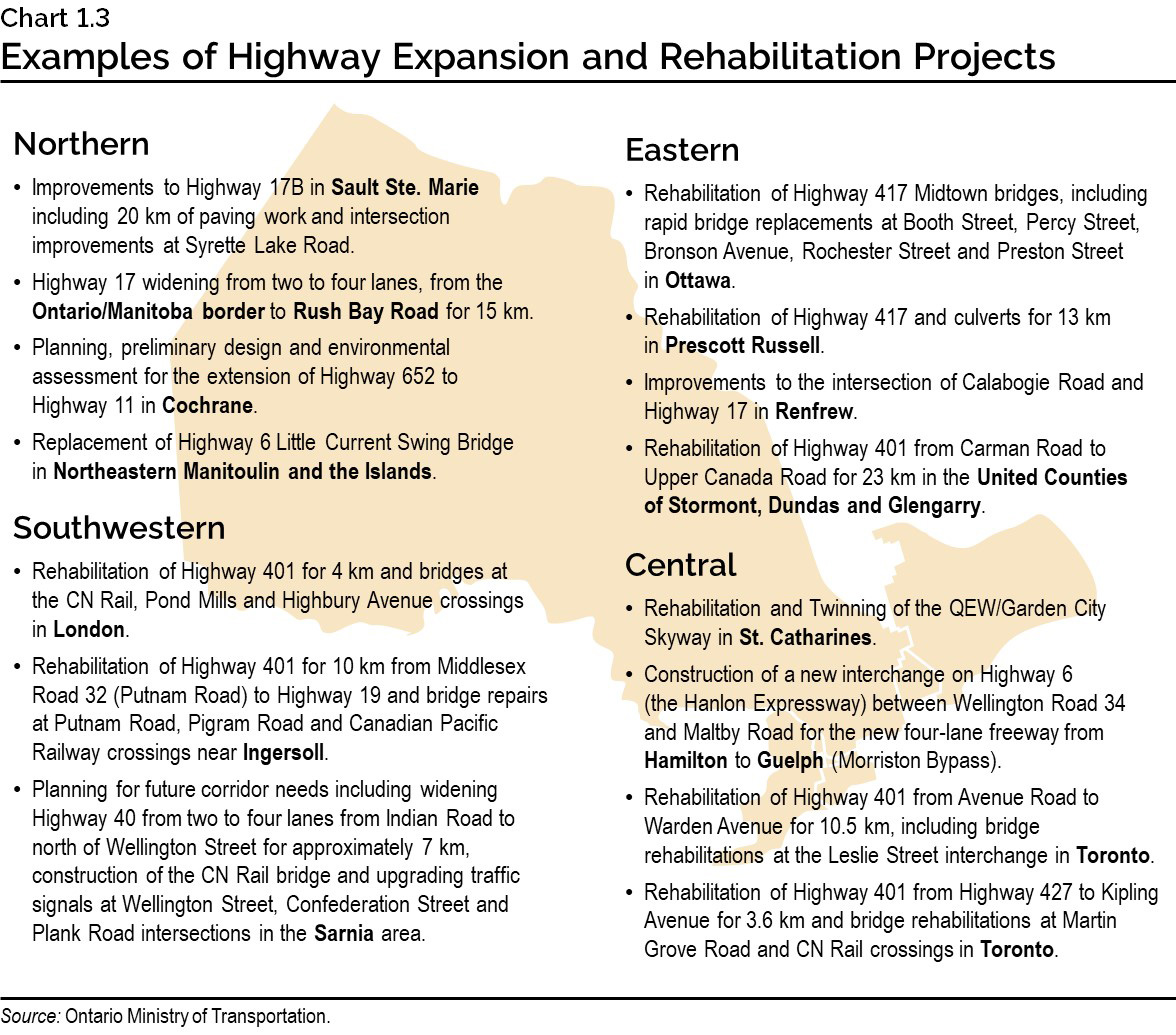
Building Subways
In the 2019 Budget, the Province announced its historic new vision for transit in the GTA. This includes Ontario’s bold $28.5 billion plan for the largest subway expansion in Canadian history with the all-new Ontario Line, the three-stop Scarborough Subway Extension, the Yonge North Subway Extension and the Eglinton Crosstown West Extension.
Through future stages of the Eglinton Crosstown West Extension project, the Province is also committed to establishing connectivity to one of the region’s largest employment and economic hubs, Pearson International Airport.
The combined subway projects will support more than 16,000 jobs annually during construction. By 2041, the projects will have a total daily ridership of roughly 620,000 and expand the existing network by 50 per cent. Recent milestones include:
- The tunnel boring machines for the Scarborough Subway Extension and the Eglinton Crosstown West are expected to arrive in Canada in January 2022 and start tunnelling in the spring.
- In May 2021, the Province awarded contracts to design, build and finance the tunnels for the Eglinton Crosstown West Extension and the Scarborough Subway Extension projects.
- Over the course of this year, Ontario has officially broken ground on the Scarborough Subway Extension and the Eglinton Crosstown West Extension.
- In June 2021, the Province invited qualified companies to submit bids for early works at Exhibition Station that will support both future Ontario Line and GO Rail Expansion construction.
- In July 2021, the Province announced it is moving ahead with a fourth station at Clark Avenue along the Yonge North Subway Extension. Clark Station will serve 2,500 riders during the busiest travel times and offer seamless transfers between the Yonge North Subway Extension and the planned branch of York Region’s Viva Orange bus rapid transit service.
- In September 2021, Ontario released the Request for Qualifications (RFQ) for the design and delivery of the stations, rail and systems work for the Scarborough Subway Extension. A shortlist of qualified proponents will be announced in early 2022 following the close of the RFQ.
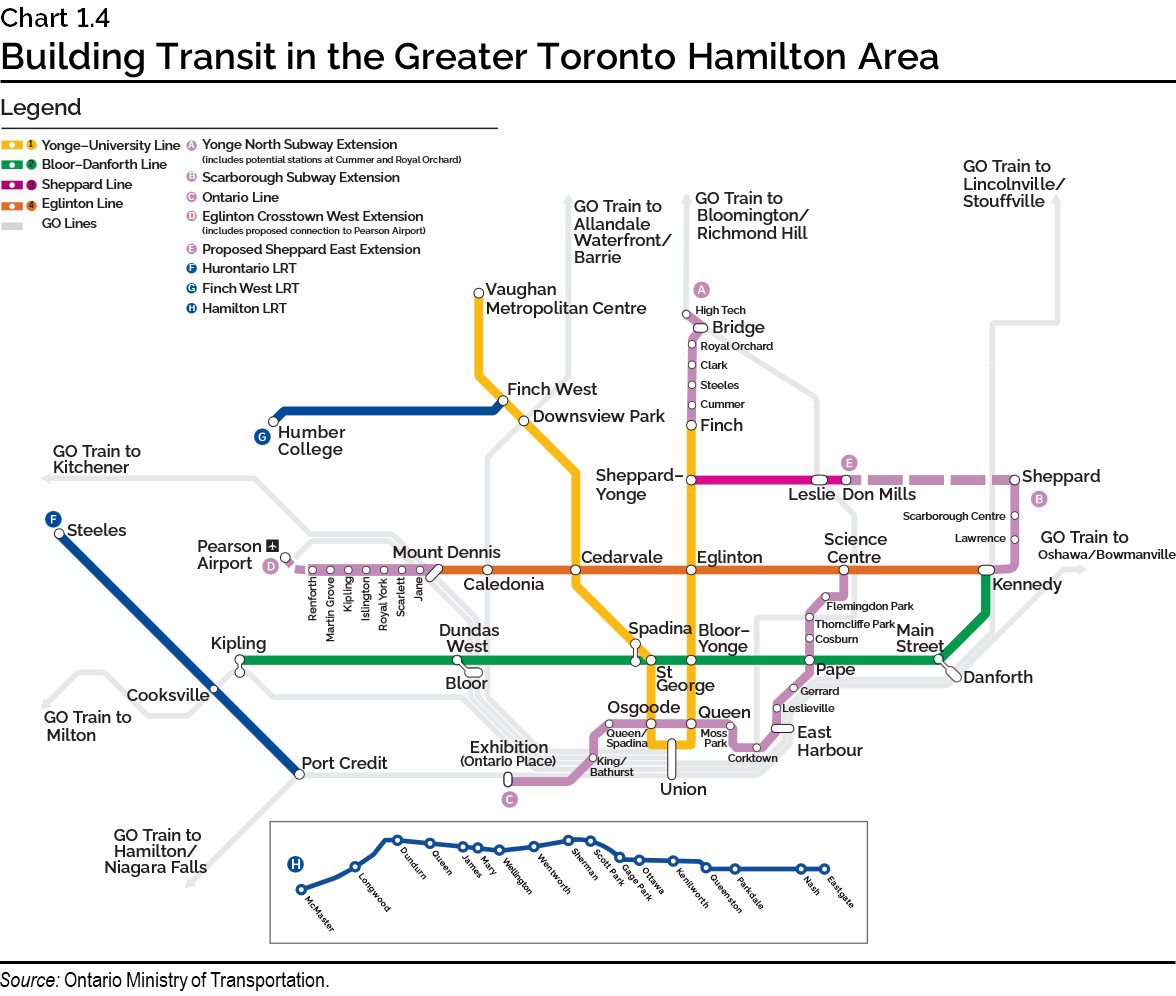
Building Transit for Hamilton
Ontario continues to work closely with the City of Hamilton and the federal government to advance the Hamilton LRT project — Ontario’s fifth priority transit project. This shovel-ready project is a 14-kilometre line that will offer service from McMaster University through downtown Hamilton to Eastgate Square.
In May 2021, Ontario increased its contribution to $1.7 billion to support construction. In September 2021, the Province signed a Memorandum of Understanding with the City of Hamilton establishing the roles and responsibilities between all parties for the project’s delivery.
Funding New Streetcars for the Toronto Transit Commission
Ontario is working with federal and municipal partners to support the purchase of 60 new streetcars for the Toronto Transit Commission (TTC). In May 2021, Ontario announced an investment of $180 million, which will be matched by the federal government, with the City of Toronto investing an additional $208 million towards the project. The streetcars will be produced in Thunder Bay, bringing good jobs and employment to Northern Ontario’s manufacturing sector.
Building Transit-Oriented Communities
The Transit-Oriented Communities (TOC) plan will bring more housing, jobs and recreational spaces within walking distance of new subway stations.
The Province, working with its municipal partners at the City of Toronto, is in discussions to build Transit-Oriented Communities along the new Ontario Line, including at the East Harbour Transit Hub and at Corktown, Queen-Spadina, King-Bathurst and Exhibition stations.
In September 2021, Ontario proposed two TOCs along the Yonge North Subway Extension at the Bridge and High Tech stations. The communities would include commercial, office and retail space to support approximately 14,000 new jobs in the region and improve housing supply.
Building Two-Way All-Day GO Transit

Ontario is transforming the GO rail network into a modern, reliable and fully integrated rapid transit network that will cut down on commute times across the province. Examples of improvements along the GO rail network include:
- The new Kipling Transit Hub, which was completed in May 2021, bringing improved transit infrastructure to East Mississauga and West Toronto. The transit hub provides customers with full access to the new and improved station that integrates MiWay bus service, TTC subway and bus, and GO rail as well as future GO bus service.
- Extending the Richmond Hill rail line north to the new Bloomington GO station that was completed in June 2021. The new station includes improved parking, modern customer amenities, and offers more connections to support future growth in the region.
In August 2021, Ontario began providing enhanced train service to customers in the City of Hamilton. The Province introduced hourly GO train service along the Lakeshore West Line between West Harbour GO Station and Union Station each day of the week. The extension of service will provide commuters a closer station with increased access by walking, biking and local transit.
Building the Kitchener GO Rail Expansion
The Province is taking action to deliver significant advancements to GO service between Toronto and Kitchener. In April 2021, the Province and Metrolinx released the Preliminary Design Business Case, which highlights the benefits of the two-way, all-day GO service project, with more train service and shorter travel times. The Province also launched a procurement for improved infrastructure such as track upgrades between Georgetown and Kitchener that will help enable frequent two-way train service.
The Kitchener GO Rail Expansion will transform the line into a true rapid transit experience with more trips at every station and across seven municipalities. The Kitchener Line is projected to generate 39,000 jobs owing to better transit service and have an estimated 54,000 residents within walking distance from a station with two-way, all-day service.
Expanding GO Train Service to London
Ontario is expanding GO train service to Southwestern Ontario with weekday trips between London and Toronto. Extending GO train service to London is part of the Province’s transportation plan for Southwestern Ontario.
In October 2021, Metrolinx launched a pilot project that will provide weekday GO train trips between London and Union Station in Toronto. The new service will extend beyond GO Transit’s Kitchener Line and will include stops in St. Marys and Stratford. The Province is working closely with VIA Rail and CN to extend service and explore ways to improve the speed and frequency of passenger rail service.
Improving Connections to Northern Ontario
The Province is improving transportation in Northeastern Ontario, making it easier and more convenient for people to get where they need to go. In May 2021, Ontario moved another step closer to this goal with the release of the Northeastern Passenger Rail Service Initial Business Case.
The Province, the Ontario Northland Transportation Commission (ONTC) and Metrolinx are moving forward with feasibility work for a route that would provide service from Toronto. The government committed $5 million through the 2021 Budget to support this feasibility work. Over the last year, the ONTC has conducted tests on the tracks to assess their readiness for service and the amount of work required to restore them to operating condition. The proposed service route would support economic opportunities, the tourism industry and improve access to health care, education, as well as other critical services.
The government plans to introduce legislative amendments to the Ontario Northland Transportation Commission Act that would further enhance and strengthen governance, accountability and oversight of the ONTC and its board. The proposed legislative amendments will better position the agency to deliver transportation services in Northern Ontario that ensure connectivity and contribute to economic prosperity by providing access to work, businesses, education and leisure activities.
Building the Ring of Fire
Promoting Prosperity in the Far North of Ontario
The Far North is a vast region in Ontario that has a population of approximately 24,000 people, of which 90 per cent identify as First Nations, living mainly in remote, fly-in communities. It is also a region of staggering beauty and significant economic potential for its communities and its people.
The Far North Act, 2010 provides community-based land-use planning in the Far North through a joint planning process between First Nations and the Province. The Ontario government has heard the concerns of both First Nations and Northern communities about the Far North Act, 2010, and is proposing amendments that will respect Aboriginal and Treaty rights and create the certainty needed to unlock the economic potential of the region in a way that is environmentally sustainable and protects the North’s rich natural beauty and heritage.
Ontario is proposing amendments to the Far North Act, 2010 that would keep current land-use plans in place and retain provisions that allow for joint land-use planning with Far North First Nations, while amending or repealing current prohibitions on development in areas without an approved land-use plan. The amendments will encourage collaboration between Ontario and First Nations in the Far North and remove barriers to economic development. Examples of significant legacy infrastructure projects that would benefit from these changes are the all-season roads for First Nation communities and mineral development opportunities in the Ring of Fire. Proposed changes would also encourage the use of traditional knowledge and perspectives on protection and conservation for the purposes of land-use planning.
The proposed amendments to the Far North Act, 2010 would support a more stable environment for investment that will bring jobs and prosperity to workers in Ontario’s North. These proposals would help support the development of valuable critical minerals that are used in various industries and products. Examples include cobalt, lithium, manganese, nickel, graphite and copper, which can be found in batteries for low-emission electric vehicles as well as energy storage systems. In addition, zinc, platinum group elements, rare earth elements, titanium and nickel are used in medical equipment and technologies including cardiac implants, magnetic resonance imaging (MRI) machines, monitoring devices and fibres for prosthetic devices.
Building the Road to the Ring of Fire Together
The Ring of Fire is one of the most promising mineral deposits in the history of Ontario, and will play a key role in the future of clean manufacturing in Ontario. It will create jobs, unlock critical minerals and bring multi-generational economic prosperity to Northern and First Nation communities. All-season, dependable road access is a prerequisite to unlocking opportunity in the region that will provide a corridor to prosperity for the remote First Nations living in the Far North. Critical legacy infrastructure such as all‑season roads and high-speed internet will also improve the well-being of First Nations and Northern communities as well as enhancing access to health and social services, supporting food security and reducing the overall cost of living.
Marten Falls and Webequie First Nations are leading Individual Environmental Assessments for proposed all-season road projects to meet the needs of their communities. In October 2021, the Minister of the Environment, Conservation and Parks approved the Terms of Reference for the Marten Falls Community Access Road Environmental Assessment and the Terms of Reference for the Webequie Supply Road Environmental Assessment.
The Province has committed close to $1 billion to support the planning and construction of the all‑season road network and other projects, including recent investments in high-speed internet, road upgrades and community supports.
The Ring of Fire is a critical project and it requires a full federal funding partner. The Government of Canada must step up and match Ontario’s commitments. For years, Ontario has called on the federal government to invest in this project, and now is the time to come to the table and support this economic opportunity of national importance.
Building Community Infrastructure
Building and repairing municipal infrastructure is essential for providing reliable and sustainable services to the people of Ontario. These investments directly support public safety, job creation and economic growth.
This is why Ontario is doubling its annual investment in the Ontario Community Infrastructure Fund (OCIF) program with an additional $1 billion over five years. This brings the total funding in OCIF to nearly $2 billion over five years, helping 424 small, rural and Northern communities construct and rehabilitate roads, bridges, water and wastewater infrastructure. This includes critical projects like road repairs in Sarnia, Georgina and Haldimand County as well as upgrades to water treatment plants in Tay Township, Blind River and West Nipissing.
These infrastructure projects will contribute to the province’s economic growth by creating 1,500 jobs annually over the next five years and will help lay the foundation for Ontario’s long-term economic recovery and prosperity.
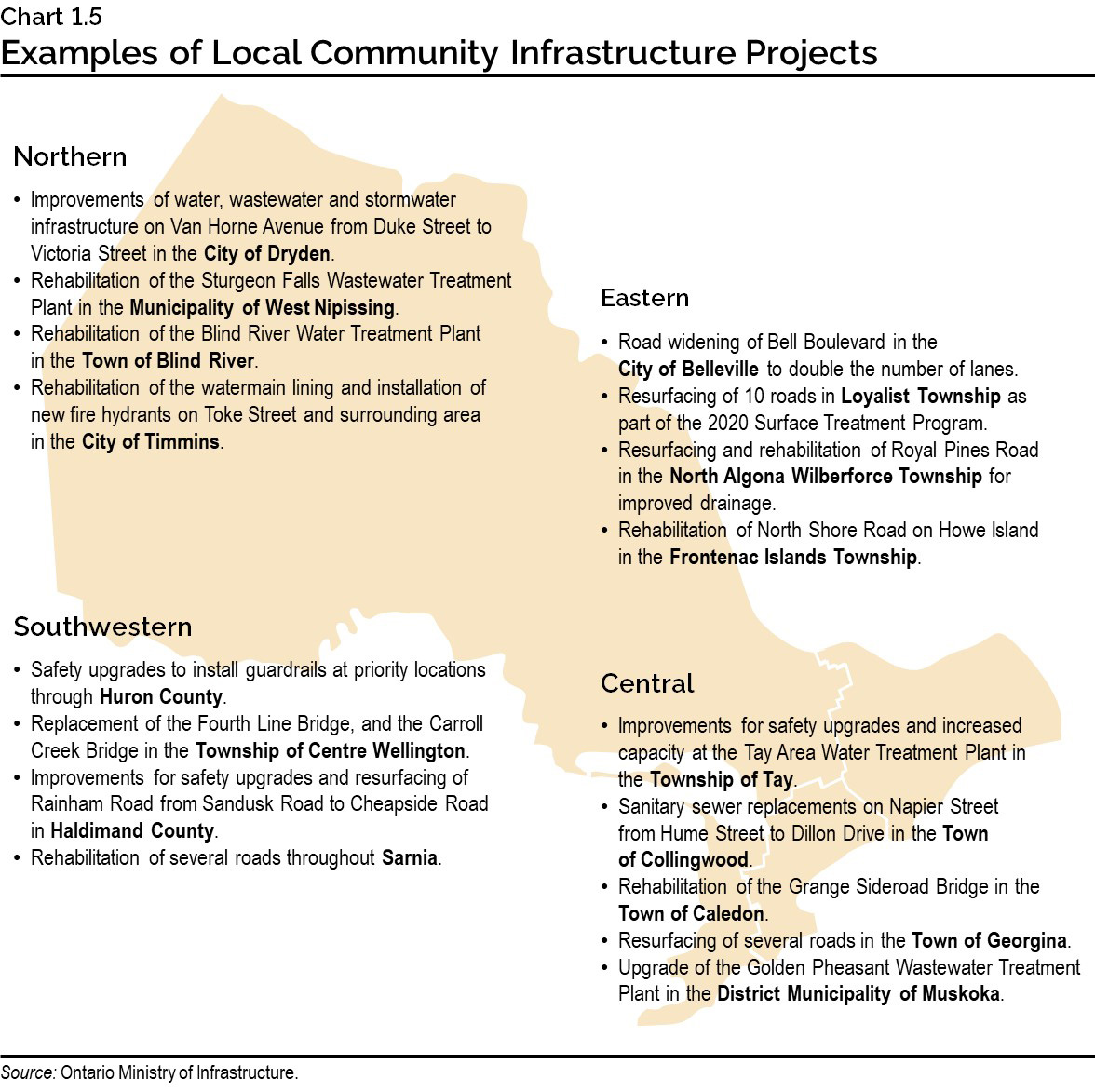
Building Better Long-Term Care Beds Faster
Having a long-term care bed available, when it is needed, is a key component of fixing long-term care for our loved ones.
The government is taking action to create a long-term care sector that provides the highest quality of care for the most vulnerable people of Ontario. New beds built to modern design standards will help prevent and contain the transmission of infectious diseases and ensure residents have access to the care they need in a safe and comfortable environment.
As announced in spring 2021, the government has made historic investments of $2.68 billion ― supporting 20,161 new and 15,918 upgraded long-term care beds in the development pipeline. This is two-thirds of the way to meeting the government’s commitment of 30,000 net new long-term care beds by 2028.
Building on this, the government plans to invest an additional $3.7 billion, beginning in 2024–25, to support building an additional 10,000 net new long-term care beds and upgrading more than 12,000 existing beds to modern design standards.
These historic investments would bring the total to $6.4 billion since spring 2019 and will result in a development pipeline of more than 30,000 net new beds and about 28,000 upgraded beds.
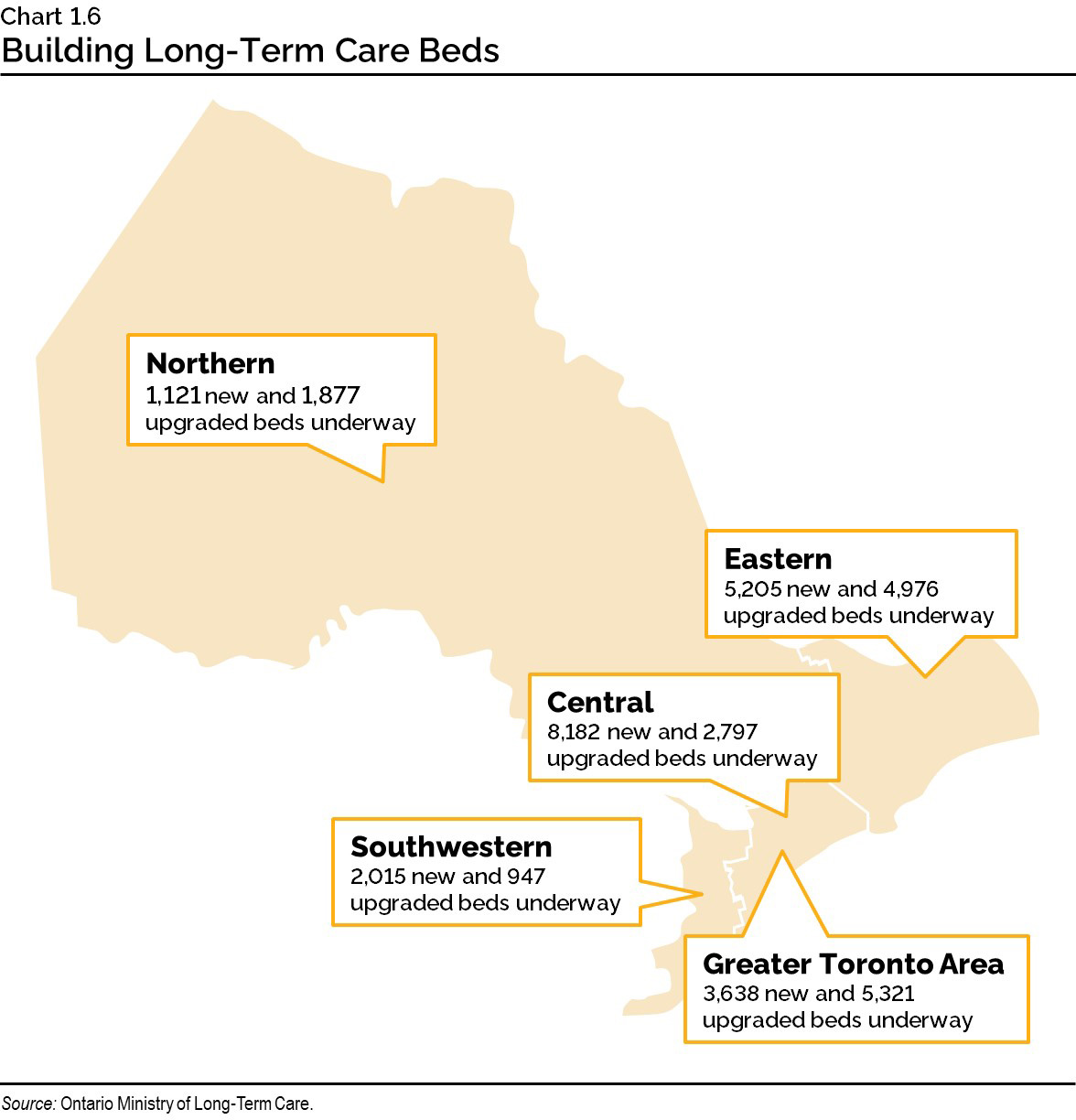
Accelerated Build Pilot
In addition to these historic investments, Ontario is making progress on building capacity in the sector through the innovative Accelerated Build Pilot, which leverages hospital-owned land and accelerated construction techniques to build four new homes faster. Construction is well underway at hospital sites in Mississauga, Ajax and Toronto. Most recently, Ontario celebrated the topping-off of the long-term care home at the Lakeridge Health Ajax Pickering Hospital after only eight months of construction. Once complete, the home will have 320 new long-term care beds.
Other recent long-term care projects have reached important milestones. For example, the government recently celebrated the openings of The Grove Nursing Home in Arnprior, Faith Manor Nursing Home in Brampton and Mon Sheong Stouffville Long-Term Care Centre in Whitchurch-Stouffville. These projects have created a combined 396 net new and 180 upgraded long-term care beds ― modern, safe and comfortable spaces for residents in these communities.
Building New Hospital Infrastructure
To support growing demands on the health care system, Ontario is investing $30.2 billion over the next 10 years in infrastructure to address longstanding challenges around hospital bed shortages in the hospital sector. These investments will increase capacity in hospitals, build new health care facilities, and renew existing hospitals and community health centres.
Expansion and renewal of hospitals remains a priority to ensure the province has a health care system that puts patients first. To address increasing demand in growing communities, the government is investing in historic hospital expansion and construction projects across the province. This includes building a new inpatient care hospital at the William Osler Health System ― Peel Memorial Centre for Integrated Health & Wellness (Peel Memorial) in Brampton and delivering on critical expansions of the Trillium Health Partners hospitals in Mississauga and Etobicoke.
Facilities including those in Bruce County, Kingston, Collingwood and Moosonee will soon have access to new state-of-the-art health care facilities. Planning at the London Health Sciences Centre is underway to double the Stem Cell Transplant Unit capacity to address regional demand. The Province is funding the planning of a new regional acute care hospital in Windsor-Essex, which will centralize acute care services in one location.
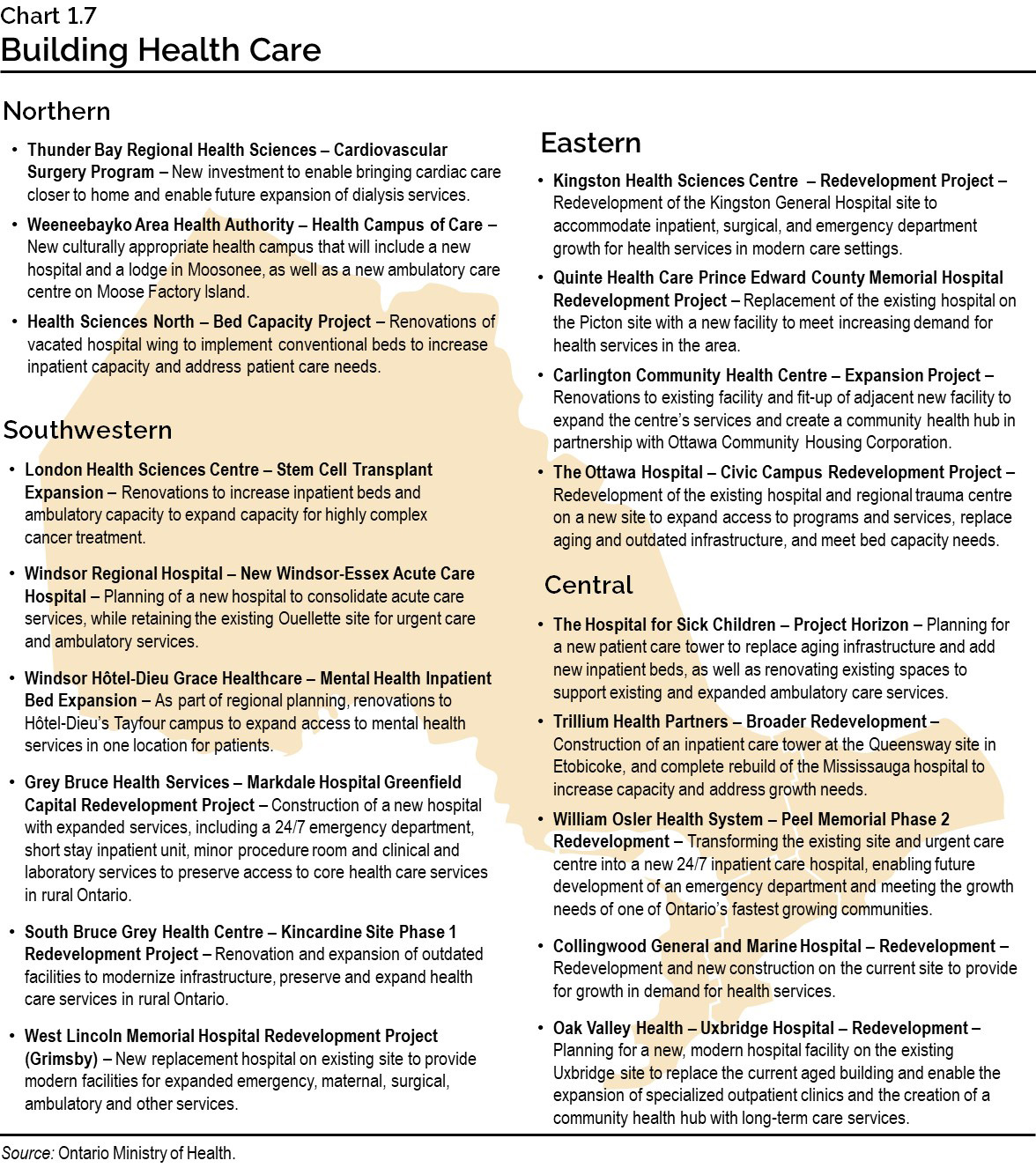
Building a Revitalized Ontario Place
In July, the government announced details of its plan to revitalize Ontario Place into a world-class destination. Ontario Place will remain open to the public 365 days a year, with free public access and a waterfront experience that can be enjoyed by all.
Across the site, public spaces will be enhanced and brought up to modern standards with new parks, promenades, trails, as well as beaches. Key heritage and recreational features of Ontario Place will be retained and integrated into the redevelopment, including the Cinesphere, the pod complex, the marina, Trillium Park and the William G. Davis Trail. The Province will also work with the Ontario Science Centre to explore opportunities to have science-related tourism and educational programming at the preserved and restored Cinesphere and pod complex.
The Province actively searched for the best global partners to work with on the redevelopment of Ontario Place. The three successful partners will help deliver an exciting, inclusive and family friendly experience that will play a key role in the province’s post-pandemic recovery, both as a tourism destination and as a display of Ontario’s strong cultural identity.
Informed through consultation with the people of Ontario, the redevelopment of Ontario Place is expected to create more than 3,600 construction jobs and staff positions once the attractions open to the public, with approximately five million visitors expected annually.
Building Schools and Child Care Spaces
Investing in schools helps support the long-term success of students. This is why the government is investing about $14 billion in capital grants over 10 years to construct more schools, improve existing facilities across Ontario and support education-related projects. As part of this investment, the government is providing $1.4 billion for the 2021–22 school year to support the repair and renewal of schools, including upgrading ventilation systems. Over five years, the government is investing up to $1.0 billion to create up to 30,000 licensed child care spaces for families and communities across the province.
Building More Homes
In June 2019, Ontario passed the More Homes, More Choice Act, 2019. The comprehensive legislation was central to the government’s More Homes, More Choice: Ontario’s Housing Supply Action Plan, which outlined a suite of legislative, regulatory and policy changes that have helped lay the groundwork needed to tackle Ontario’s housing crisis by eliminating duplication and barriers to help build more homes for the people of Ontario. While cutting red tape, the government has held firm to its commitment of maintaining protections for public health and safety, the environment, the Greenbelt, agricultural lands and Ontario’s rich natural and cultural heritage.
Initiatives under Ontario’s Housing Supply Action Plan are already working to streamline and speed up the development of new housing. For example:
- To build more homes that meet the needs of the people of Ontario, $25.6 billion was invested in new housing in 2020 in the province — $4.5 billion more than in 2019. This trend has continued — the year-to-date investment in 2021 is 49 per cent higher than the equivalent period in 20201;
- More homes started construction in 2020 (73,838) than in any year of the past decade. In addition, year-to-date starts in 2021 are currently 16 per cent higher than the equivalent period in 20202; and
- Rental construction has surged — rental housing starts in 2020 (10,954) were the highest since 1992; rental starts to date in 2021 are currently 14 per cent higher than the equivalent period in 20203.
When fully implemented by 2022, efforts to streamline development approvals will result in accelerated timelines and cost savings. The government is also making additional improvements to the land-use planning system, like allowing municipalities to delegate minor changes to their zoning by-laws to their staff to administer.
The government is proposing enhancements to the Brownfields Financial Tax Incentive Program to encourage the rehabilitation of contaminated land and support new housing development.
The Province will continue to work with all levels of government to help ensure that everyone in Ontario has a home they can afford.
While Ontario is already seeing signs of progress and housing starts have trended upwards, there is still more to do. As a next step, the government proposes to establish a Housing Affordability Task Force to provide recommendations to the Minister of Municipal Affairs and Housing on potential further actions to make housing more affordable for Ontario families.
Building High-Speed Internet

High-speed internet is critical for access to vital services like health care, education and employment, while increasing economic and entrepreneurial opportunities for the people of Ontario. It is estimated that as many as 700,000 households and businesses in Ontario lack access to high-speed internet or have no internet connection at all. In the 2021 Budget, the Province committed a historic $2.8 billion to make high-speed internet accessible in all regions of the province by the end of 2025, increasing Ontario’s overall investment in broadband to nearly $4 billion over six years beginning in 2019–20.
The government is moving quickly to speed up Ontario’s broadband expansion. On April 12, 2021, the Ontario Legislature passed the Supporting Broadband and Infrastructure Expansion Act, 2021 to accelerate the deployment of broadband infrastructure and get households connected faster.
The Province has also successfully partnered with the federal government to invest up to $1.2 billion to connect up to 300,000 households in hundreds of communities through the Improving Connectivity for Ontario (ICON) program and the federal Universal Broadband Fund program.
Ontario is also diversifying the province’s broadband infrastructure by investing more than $109 million in Telesat’s next-generation Low Earth Orbit satellite network, to help secure future access to dedicated high-speed bandwidth for local communities.
The government is also making investments across the province, including a $71 million investment in the Eastern Ontario Regional Network (EORN) to improve access to cellular service and mobile broadband in Eastern Ontario. Additionally, the Province is investing up to $64 million in the Southwestern Integrated Fibre Technology (SWIFT) project to bring high-speed internet to 63,000 more homes and businesses across Southwestern Ontario. In addition, Ontario is investing in initiatives to improve connectivity in Northern Ontario, including $10.9 million to bring faster internet connections to several First Nations and Northern communities.
Ontario is also delivering on the government’s plan to expedite broadband access by issuing a world-leading broadband expansion program guideline that further supports and deepens positive and collaborative relationships between Internet Service Providers (ISPs), utility companies and municipalities, while holding all parties to account. This partnership will help support timely and efficient expansion of broadband across the province.
Building Stronger Supply Chains
The COVID‑19 pandemic revealed challenges in securing critical supplies and equipment, such as personal protective equipment (PPE), to safeguard the people of Ontario, including frontline workers and vulnerable persons. Since the onset of the pandemic, Ontario has been procuring these supplies and equipment through its traditional suppliers as well as working directly with manufacturers, including Ontario-based vendors that were able to retool and respond to Ontario’s call to action. For example, Barrie-based company Southmedic Inc., with support from the Ontario Together Fund, is leveraging existing production processes, materials and supply chain networks to strengthen Ontario’s supply of PPE.
On November 16, 2020, the government formally announced the creation of Supply Ontario, a new centralized procurement agency that will enable a whole-of-government approach to purchasing goods and services for the public, broader public sector and health sectors — leveraging provincial purchasing power to ensure consistent access to high-quality and reliable products at the best value for the people of Ontario. To further strengthen Ontario’s supply chains, the government is also introducing the Building Ontario Business initiative to help level the playing field by reducing barriers and giving Ontario and Canadian companies opportunities to secure public-sector contracts and create new opportunities and jobs for Ontario.
Transforming the Government’s Approach to Real Estate
While real estate is one of the government’s greatest resources, there is no consistent framework on addressing best practices to guide decision-making. Taking a government-wide approach will help drive leaner processes and greater efficiencies, and allow the government to realize greater value nimbly and efficiently from government real estate, maximizing the value for Ontario taxpayers.
This is why the government will establish a “Centre of Realty Excellence” (CORE), creating one holistic sight line across the public sector for the Ontario government to determine priority surplus properties aligned with key initiatives, including building long-term care.
Footnotes
[1] Canada Mortgage Housing Corporation, Starts and Completions Survey, population centres 50k+, monthly data (year-to-date figures represent the period from January to September of a given year. Figures are current as of October 18, 2021).
[2] Starts and Completions Survey 2021.
[3] Starts and Completions Survey 2021.
Chart Descriptions
Chart 1.3: Examples of Highway Expansion and Rehabilitation Projects
This map shows examples of expansion and rehabilitation projects that have committed construction funding and are either underway or currently planned, including across different regions in Ontario.
Northern
- Improvements to Highway 17B in Sault Ste. Marie including 20 km of paving work and intersection improvements at Syrette Lake Road.
- Highway 17 widening from two to four lanes, from the Ontario/Manitoba border to Rush Bay Road for 15 km.
- Planning, preliminary design and environmental assessment for the extension of Highway 652 to Highway 11 in Cochrane.
- Replacement of Highway 6 Little Current Swing Bridge in Northeastern Manitoulin and the Islands.
Eastern
- Rehabilitation of Highway 417 Midtown bridges, including rapid bridge replacements at Booth Street, Percy Street, Bronson Avenue, Rochester Street and Preston Street in Ottawa.
- Rehabilitation of Highway 417 and culverts for 13 km in Prescott Russell.
- Improvements to the intersection of Calabogie Road and Highway 17 in Renfrew.
- Rehabilitation of Highway 401 from Carman Road to Upper Canada Road for 23 km in the United Counties of Stormont, Dundas and Glengarry.
Southwestern
- Rehabilitation of Highway 401 for 4 km and bridges at the CN Rail, Pond Mills and Highbury Avenue crossings in London.
- Rehabilitation of Highway 401 for 10 km from Middlesex Road 32 (Putnam Road) to Highway 19 and bridge repairs at Putnam Road, Pigram Road and Canadian Pacific Railway crossings near Ingersoll.
- Planning for future corridor needs including widening Highway 40 from two to four lanes from Indian Road to north of Wellington Street for approximately 7 km, construction of the CN Rail bridge and upgrading traffic signals at Wellington Street, Confederation Street and Plank Road intersections in the Sarnia area.
Central
- Rehabilitation and Twinning of the QEW/Garden City Skyway in St. Catharines.
- Construction of a new interchange on Highway 6 (the Hanlon Expressway) between Wellington Road 34 and Maltby Road for the new four-lane freeway from Hamilton to Guelph (Morriston Bypass).
- Rehabilitation of Highway 401 from Avenue Road to Warden Avenue for 10.5 km, including bridge rehabilitations at the Leslie Street interchange in Toronto.
- Rehabilitation of Highway 401 from Highway 427 to Kipling Avenue for 3.6 km and bridge rehabilitations at Martin Grove Road and CN Rail crossings in Toronto.
Source: Ontario Ministry of Transportation.
Chart 1.4: Building Transit in the Greater Toronto Hamilton Area
This map shows various transit lines in the Greater Toronto Hamilton Area (GTHA) highlighting the following:
Yonge-University Line
- Provides two-way subway service from Finch Station to Vaughan Metropolitan Centre Station connecting North York and Vaughan.
- Key stops from east to west include Sheppard-Yonge, Eglinton, Bloor-Yonge, Queen, Union, St George, Spadina, Cedarvale/Eglinton West, Downsview Park and Finch West.
Bloor-Danforth Line
- Provides two-way subway service from Kennedy Station to Kipling Station connecting Scarborough to Etobicoke.
- Key stops from east to west include Main Street, Pape, Bloor-Yonge, St George, Spadina and Dundas West.
Sheppard Line
- Provides two-way subway service from Don Mills Station to Sheppard-Yonge Station in North York with a key stop at Leslie Station.
Eglinton Line
- Provides two-way light rail service from Kennedy Station to Mount Dennis Station along Eglinton Avenue.
- Key stops from east to west include Science Centre, Eglinton, Cedarvale and Caledonia.
GO Lines
- The Barrie Line provides GO train service from Union Station in downtown Toronto to Allandale Waterfront Station in Barrie.
- The Kitchener Line provides GO train service from Union Station in downtown Toronto to Kitchener.
- The Lakeshore East Line provides GO train service from Union Station in downtown Toronto to Oshawa/Bowmanville.
- The Lakeshore West Line provides GO train service from Union Station in downtown Toronto to both Hamilton and Niagara Falls.
- The Milton Line provides GO train service from Union Station in downtown Toronto to Milton.
- The Richmond Hill Line provides GO train service from Union Station in downtown Toronto to Bloomington Station in Richmond Hill.
- The Stouffville Line provides GO train service from Union Station in downtown Toronto to Lincolnville Station in Stouffville.
Yonge North Subway Extension
- Will provide additional two-way subway service north of Finch Station with four new additional stations — Steeles, Clark, Bridge and High Tech.
- Two potential stations at Cummer and Royal Orchard.
Scarborough Subway Extension
- Will provide additional two-way subway service northeast of Kennedy Station with three new stations — Lawrence, Scarborough Centre and Sheppard.
Ontario Line
- Will provide additional two-way subway service connecting the Ontario Science Centre to Exhibition Place through downtown Toronto.
- The new line will feature 15 stops including Flemingdon Park, Thorncliffe Park, Cosburn, Pape, Gerrard, Leslieville, East Harbour, Corktown, Moss Park, Queen, Osgoode, Queen/Spadina and King/Bathurst.
Eglinton Crosstown West Extension
- Will provide additional light rail service west of the future Mount Dennis station with seven new proposed stops at Jane, Scarlett, Royal York, Islington, Kipling, Martin Grove and Renforth.
- Includes a proposed connection to Pearson Airport.
Proposed Sheppard East Extension
- Would provide additional two-way subway service by expanding the existing Sheppard Line east of Don Mills Station to the new Sheppard Station in Scarborough.
Hurontario LRT
- Will provide new light rail service in Peel Region connecting Port Credit Station in Mississauga to Steeles Station in Brampton along Hurontario Street.
Finch West LRT
- Will provide new light rail service connecting Finch West Station on the Yonge-University Line to Humber College.
Hamilton LRT
- Will provide new light rail service connecting Eastgate Square to McMaster University through downtown Hamilton.
- The new line will feature 17 stops including Nash, Parkdale, Queenston, Kenilworth, Ottawa, Gage Park, Scott Park, Sherman, Wentworth, Wellington, Mary, James, Queen, Dundurn and Longwood.
Source: Ontario Ministry of Transportation.
Chart 1.5: Examples of Local Community Infrastructure Projects
This map provides examples of local community infrastructure projects across Ontario that were recently completed.
Northern
- Improvements of water, wastewater and stormwater infrastructure on Van Horne Avenue from Duke Street to Victoria Street in the City of Dryden.
- Rehabilitation of the Sturgeon Falls Wastewater Treatment Plant in the Municipality of West Nipissing.
- Rehabilitation of the Blind River Water Treatment Plant in the Town of Blind River.
- Rehabilitation of the watermain lining and installation of new fire hydrants on Toke Street and surrounding area in the City of Timmins.
Eastern
- Road widening of Bell Boulevard in the City of Belleville to double the number of lanes.
- Resurfacing of 10 roads in Loyalist Township as part of the 2020 Surface Treatment Program.
- Resurfacing and rehabilitation of Royal Pines Road in the North Algona Wilberforce Township for improved drainage.
- Rehabilitation of North Shore Road on Howe Island in the Frontenac Islands Township.
Southwestern
- Safety upgrades to install guardrails at priority locations through Huron County.
- Replacement of the Fourth Line Bridge, and the Carroll Creek Bridge in the Township of Centre Wellington.
- Improvements for safety upgrades and resurfacing of Rainham Road from Sandusk Road to Cheapside Road in Haldimand County.
- Rehabilitation of several roads throughout Sarnia.
Central
- Improvements for safety upgrades and increased capacity at the Tay Area Water Treatment Plant in the Township of Tay.
- Sanitary sewer replacements on Napier Street from Hume Street to Dillon Drive in the Town of Collingwood.
- Rehabilitation of the Grange Sideroad Bridge in the Town of Caledon.
- Resurfacing of several roads in the Town of Georgina.
- Upgrade of the Golden Pheasant Wastewater Treatment Plant in the District Municipality of Muskoka.
Source: Ontario Ministry of Infrastructure.
Chart 1.6: Building Long-Term Care Beds
This map provides the number of new and upgraded long-term care beds in the development pipeline across the province.
Northern
- 1,121 new and 1,877 upgraded beds underway
Eastern
- 5,205 new and 4,976 upgrades beds underway
Central
- 8,182 new and 2,797 upgraded beds underway
Southwestern
- 2,015 new and 947 upgraded beds underway
Greater Toronto Area
- 3,638 new and 5,321 upgraded beds underway
Source: Ontario Ministry of Long-Term Care.
Chart 1.7: Building Health Care
This map provides examples of health facility projects under construction or in planning across Ontario.
Northern
- Thunder Bay Regional Health Sciences – Cardiovascular Surgery Program – New investment to enable bringing cardiac care closer to home and enable future expansion of dialysis services.
- Weeneebayko Area Health Authority – Health Campus of Care – New culturally appropriate health campus that will include a new hospital and a lodge in Moosonee, as well as a new ambulatory care centre on Moose Factory Island.
- Health Sciences North – Bed Capacity Project – Renovations of vacated hospital wing to implement conventional beds to increase inpatient capacity and address patient care needs.
Eastern
- Kingston Health Sciences Centre – Redevelopment Project – Redevelopment of the Kingston General Hospital site to accommodate inpatient, surgical, and emergency department growth for health services in modern care settings.
- Quinte Health Care Prince Edward County Memorial Hospital Redevelopment Project – Replacement of the existing hospital on the Picton site with a new facility to meet increasing demand for health services in the area.
- Carlington Community Health Centre – Expansion Project – Renovations to existing facility and fit-up of adjacent new facility to expand the centre’s services and create a community health hub in partnership with Ottawa Community Housing Corporation.
- The Ottawa Hospital – Civic Campus Redevelopment Project – Redevelopment of the existing hospital and regional trauma centre on a new site to expand access to programs and services, replace aging and outdated infrastructure, and meet bed capacity needs.
Central
- The Hospital for Sick Children – Project Horizon – Planning for a new patient care tower to replace aging infrastructure and add new inpatient beds, as well as renovating existing spaces to support existing and expanded ambulatory care services.
- Trillium Health Partners – Broader Redevelopment – Construction of an inpatient care tower at the Queensway site in Etobicoke, and complete rebuild of the Mississauga hospital to increase capacity and address growth needs.
- William Osler Health System – Peel Memorial Phase 2 Redevelopment – Transforming the existing site and urgent care centre into a new 24/7 inpatient care hospital, enabling future development of an emergency department and meeting the growth needs of one of Ontario’s fastest growing communities.
- Collingwood General and Marine Hospital – Redevelopment – Redevelopment and new construction on the current site to provide for growth in demand for health services.
- Oak Valley Health – Uxbridge Hospital – Redevelopment – Planning for a new, modern hospital facility on the existing Uxbridge site to replace the current aged building and enable the expansion of specialized outpatient clinics and the creation of a community health hub with long-term care services.
Southwestern
- London Health Sciences Centre – Stem Cell Transplant Expansion – Renovations to increase inpatient beds and ambulatory capacity to expand capacity for highly complex cancer treatment.
- Windsor Regional Hospital – New Windsor-Essex Acute Care Hospital – Planning of a new hospital to consolidate acute care services, while retaining the existing Ouellette site for urgent care and ambulatory services.
- Windsor Hôtel-Dieu Grace Healthcare – Mental Health Inpatient Bed Expansion – As part of regional planning, renovations to Hôtel-Dieu’s Tayfour campus to expand access to mental health services in one location for patients.
- Grey Bruce Health Services – Markdale Hospital Greenfield Capital Redevelopment Project – Construction of a new hospital with expanded services, including a 24/7 emergency department, short stay inpatient unit, minor procedure room and clinical and laboratory services to preserve access to core health care services in rural Ontario.
- South Bruce Grey Health Centre – Kincardine Site Phase 1 Redevelopment Project – Renovation and expansion of outdated facilities to modernize infrastructure, preserve and expand health care services in rural Ontario.
- West Lincoln Memorial Hospital Redevelopment Project (Grimsby) – New replacement hospital on existing site to provide modern facilities for expanded emergency, maternal, surgical, ambulatory and other services.
Source: Ontario Ministry of Health.